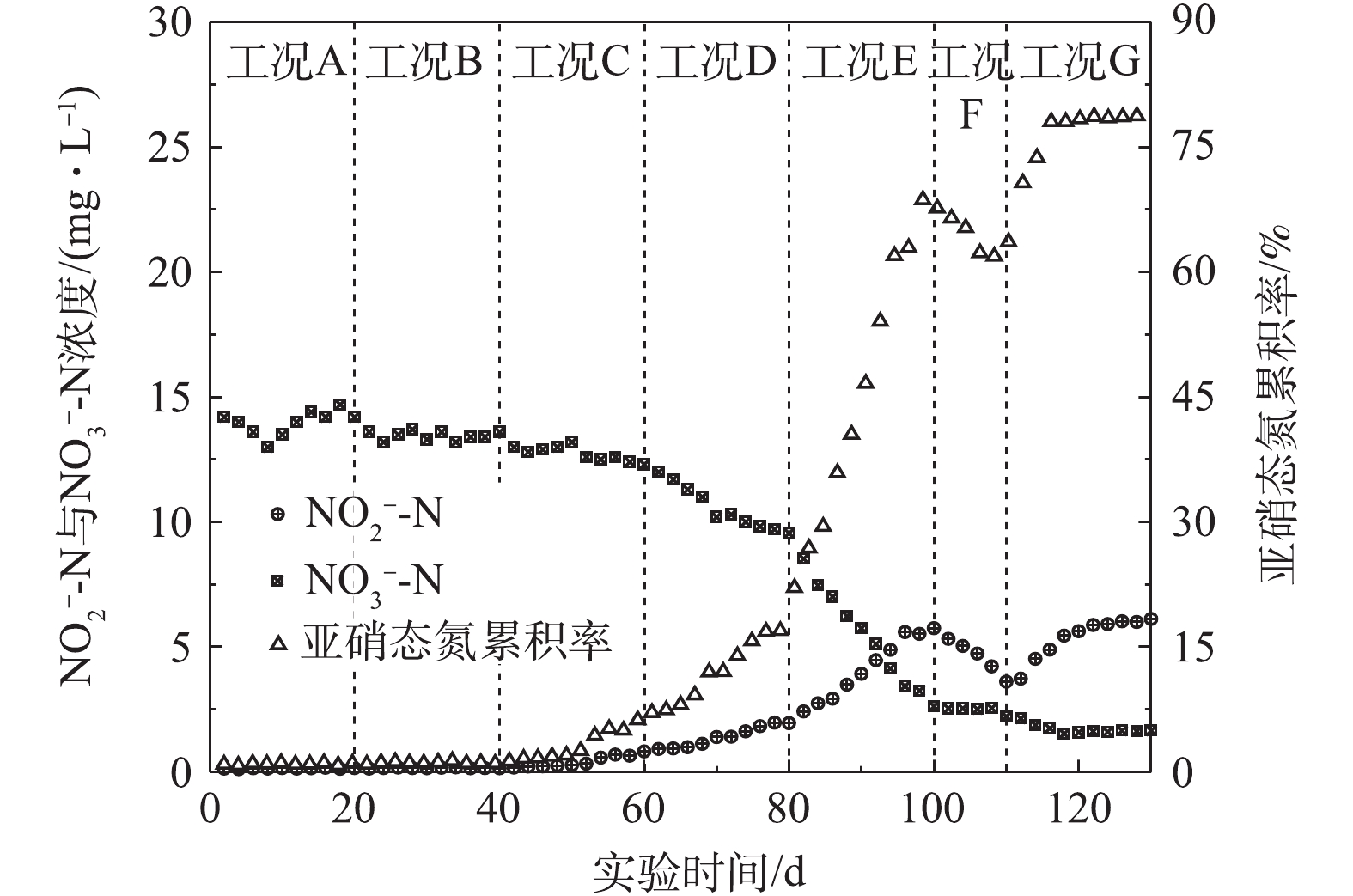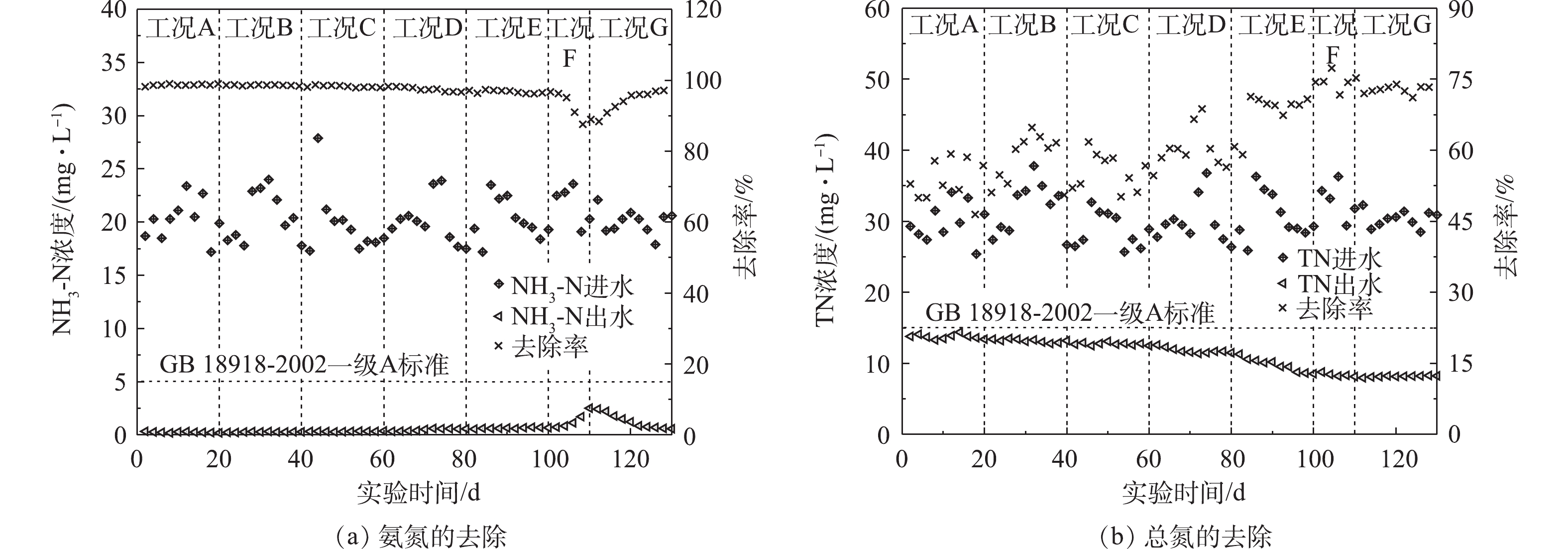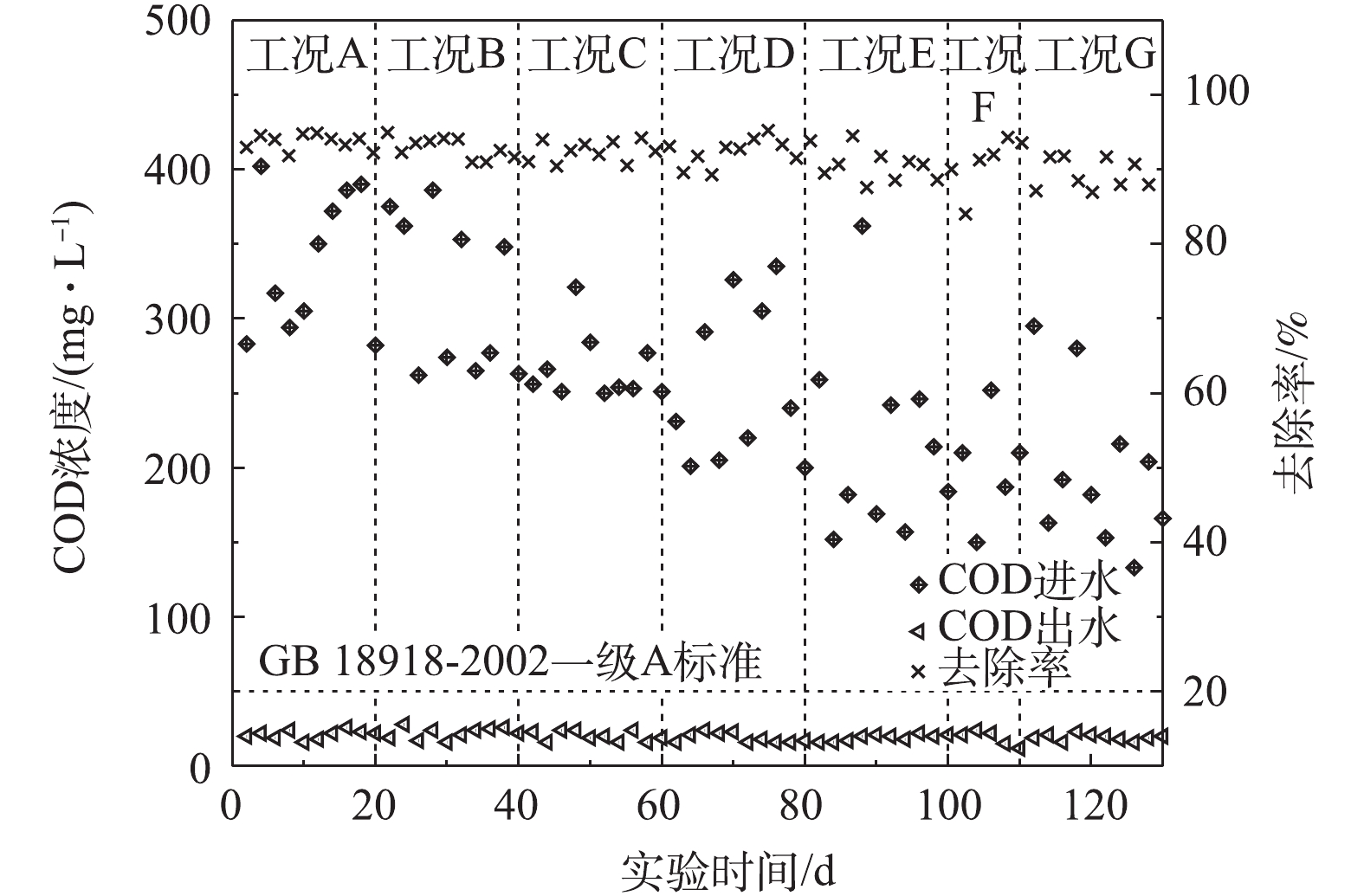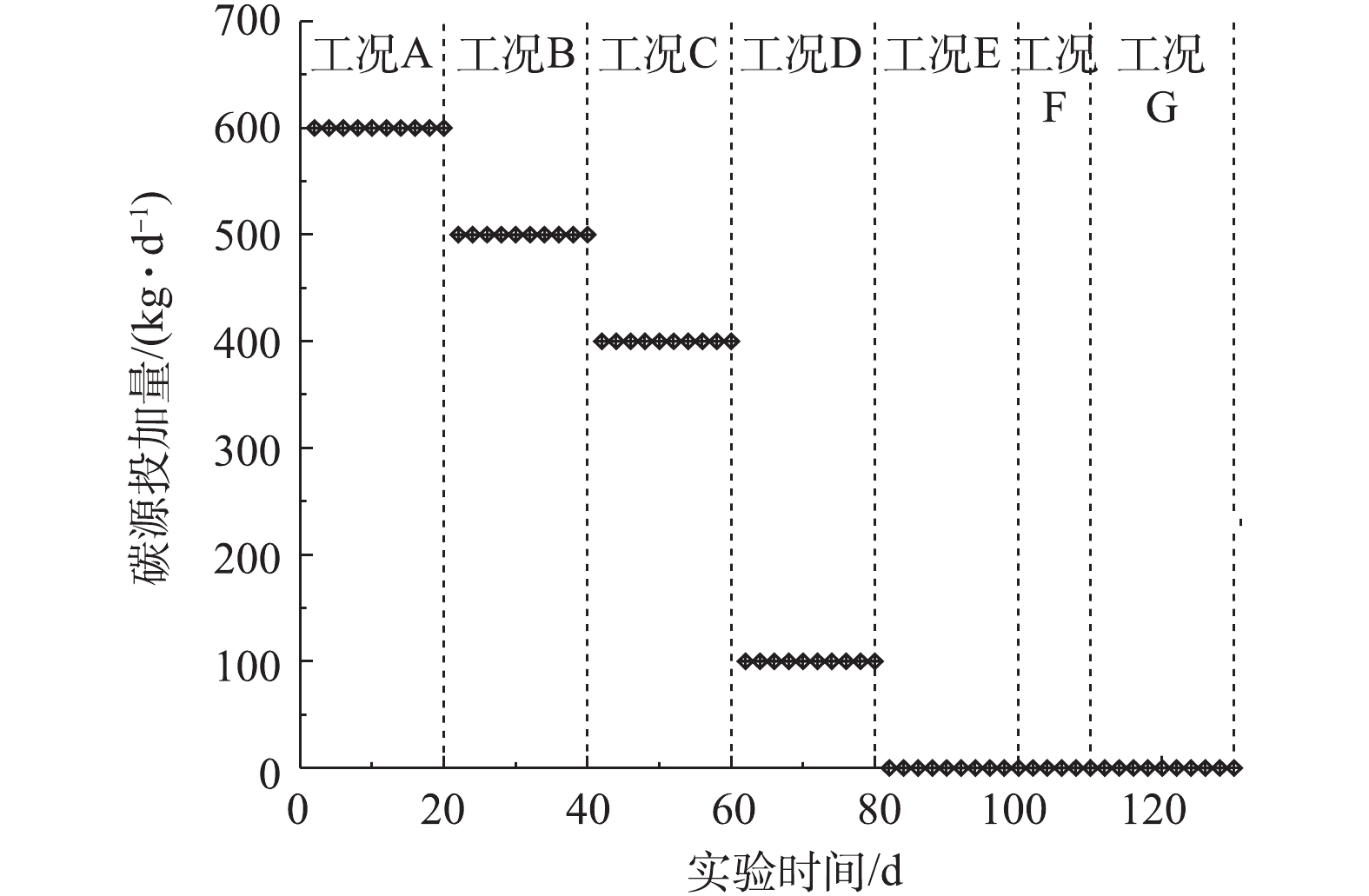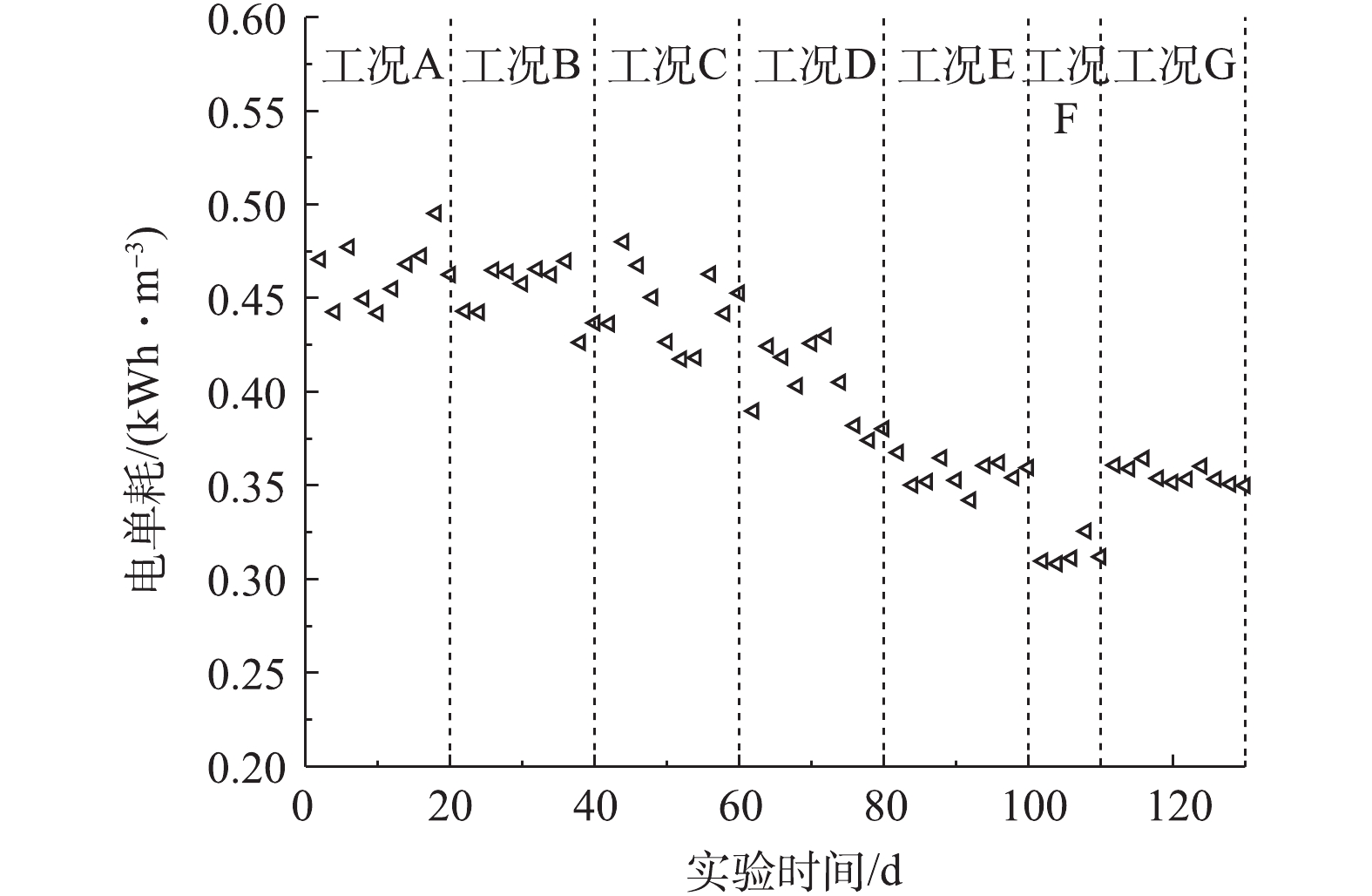-
在全程硝化反硝化工艺中,总氮的去除是在有氧环境下经由NH3-N→
NO−2 -N→NO−3 -N等一系列氧化过程,再在缺氧环境下经由NO−3 -N→NO−2 -N→N2等一系列还原过程来实现[1]。从硝化与反硝化路径可以看出,硝化反应中NO−2 -N氧化成NO−3 -N与反硝化反应中NO−3 -N还原成NO−2 -N是刚好相反的路径,如果将其从反应路径中去掉,采用短程硝化反硝化工艺,即NH3-N→NO−2 -N→N2,总氮的去除是同样可以实现的[2]。相比全程硝化反硝化工艺而言,短程硝化反硝化工艺因为略去了NO−2 -N向NO−3 -N的转化步骤,硝化阶段可节约曝气量25%左右[3-8];因为省去了NO−3 -N还原为NO−2 -N步骤,根据反应计量学,1 molNO−3 -N和1 molNO−2 -N还原为N2,分别需要2.86 mol和1.71 mol的BOD[9],从理论上讲,可节约反硝化碳源40%左右[10-12];因为整个反应路径缩短,反应器容积减小,可节约大笔污水处理厂基建费用[13-14]。成功启动短程硝化反硝化的关键在于使氨氧化细菌(AOB)达到富集状态,同时抑制亚硝态氮氧化细菌(NOB)的增殖或活性,使AOB在整个系统中成长为优势菌种,逐步将NOB淘洗出系统,从而使硝化反应中氮素的转化停留在NO−2 -N环节,达到NO−2 -N累积的目的[15-16]。当前,我国城市污水C/N普遍为3.8~8.5,属于典型低C/N污水[17-18],采用传统污水处理工艺往往会因为碳源不足,导致总氮的去除困难重重[19-20],无法满足当下国家对污水排放标准不断升级的要求。而短程硝化反硝化工艺因能节约大量反硝化碳源,实现低C/N下氮素的深度去除而备受研究人员和工程技术人员的广泛关注。高春娣等[21]在(24±2) ℃下采用交替好氧缺氧短程硝化工艺处理低C/N生活污水,
NO−2 -N累积率可稳定维持在90%以上,NH3-N的去除率可达100%,COD的去除率在80%左右,TN的去除率要高于普通好氧缺氧模式,能达到70%左右。徐浩等[22]在(30±1) ℃下成功启动短程硝化工艺,处理低C/N城市污水,NH3-N的平均转化率可达到99%,NO−2 -N的平均累积率可达90%以上。可以看出,在已有的研究中,普遍开展的是基于实验室或中试规模的中、高温条件下的短程硝化反硝化工艺研究,但将其成功应用于低温环境下的工程实践却鲜有报道。鉴于此,本研究针对低C/N城市污水,在具体工程实例中,探讨了低温环境下启动短程硝化反硝化的可行性,通过对好氧池溶解氧进行分区定量优化,实现了对好氧池的“缺氧扰动”,考察了不同溶解氧分布对短程硝化反硝化工艺的影响,从而为该工艺在实际生产运行中的优化控制提供参考。
全文HTML
-
重庆市渝北区肖家河污水处理厂一、二期项目设计规模为2×104 m3·d−1,采用A/O+滤布滤池工艺,工程占地1.3×104 m2,铺设污水截流管网16.5 km,主要收集处理服务片区内的生活污水及少量工业废水。进水水质如图1所示,出水执行《城镇污水处理厂污染物排放标准》(GB 18918-2002)一级A标。
-
肖家河污水处理厂排污口位于肖家河下游,当前肖家河水质属Ⅴ类水体,水质条件恶劣。为保护三峡库区水环境,重庆市政府要求敏感区域城镇污水处理厂排放标准全部提升至一级A标准。但肖家河污水处理厂初设时无缺氧反应工艺段,无内回流设施设备,加之进水C/N不足,碳源不充分,导致出水TN波动较大,冬季低温(实验期间系统温度:11.5~15.8 ℃)时为12.8~14.7 mg·L−1,存在严重的水质风险。
-
COD采用重铬酸盐法(HJ 828-2017)测定;TN采用碱性过硫酸钾消解紫外分光光度法(HJ 636-2012)测定;NH3-N采用蒸馏中和滴定法(HJ 537-2009)测定;
NO−2 -N采用N-(1-萘基)-乙二胺分光光度法(GB/T 7493-1987)测定;NO−3 -N采用紫外分光光度法(HJ/T 346-2007)测定;TP采用钼酸铵分光光度法(GB/T 11893-1989)测定;DO采用便携式溶解氧仪检测法(HJ 925-2017)测定。 -
本实验对A/O工艺实施好氧/缺氧交替运行模式的摸索,开展了溶解氧对短程硝化反硝化工艺脱氮效果的研究,实验时间从2018年11月上旬至次年3月中旬。由于该厂初设无内回流,所以维持较高的外回流比(150%~200%)来补充内回流。实验系统如图2所示,图2中a、b、c分别为好氧3段风管控制阀,用于控制整个生物池好氧段曝气量,确保生物池达到好氧/缺氧交替运行目的,其中,阀a为好氧前端控制阀,阀b为好氧中端控制阀,阀c为好氧尾端控制阀;仪表①、②、③分别为好氧3段在线溶解氧仪,用于实时监控整个生物池好氧段溶解氧浓度,从而指导3个风管控制阀的开度,其中,仪表①为好氧前端在线溶解氧仪,仪表②为好氧中端在线溶解氧仪,仪表③为好氧尾端在线溶解氧仪;整个A/O生物池设有3台推流器,分别安装在厌氧池、好氧池前端、好氧池中端,用于生物池中泥水混合液的导流。
调整3个风管控制阀,使生物池中的好氧段整体实现好氧/缺氧交替运行模式,人为缩短硝化进程,促使硝化反应中氮素的转化停留在
NO−2 -N环节,然后立即转入缺氧环境实现反硝化脱氮,从而提高总氮去除率。7种工况下区域Ⅰ、区域Ⅱ、区域Ⅲ溶解氧分布以及对应的MLSS、MLVSS、污泥负荷、容积负荷、产泥率、污泥龄等运行参数如表1所示。 -
亚硝态氮累积率按式(1)进行计算。
式中:R为亚硝态氮累积率;
CNO−2−N 和CNO−3−N 分别为好氧尾端NO−2 -N与NO−3 -N浓度,mg·L−1。
1.1. 污水处理厂概况
1.2. 实验背景
1.3. 分析项目与方法
1.4. 实验安排
1.5. 亚硝态氮累积率的计算
-
本实验通过对好氧池溶解氧进行分区定量优化,实现好氧/缺氧交替运行,好氧尾端氮素的形态及亚硝态氮累积情况如图3所示,氮素的去除情况如图4所示。由图3可以看出,在工况A和工况B下,好氧尾端
NO−3 -N浓度较高,平均值在13.7 mg·L−1左右波动,而NO−2 -N浓度不足0.20 mg·L−1,亚硝态氮累积率低于1.5%,此过程属于全程硝化,该工况下出水氨氮平均浓度低于0.30 mg·L−1,去除率在98%以上,但总氮浓度为12.8~14.4 mg·L−1,去除率低于60%,并接近一级A标准浓度限值。为此,对区域Ⅰ的溶解氧进行了优化,发现在工况C的后期,NO−3 -N浓度出现了轻微的下降趋势,NO−2 -N浓度从不足0.20 mg·L−1升至0.82 mg·L−1。而在工况D和工况E下,分别对区域Ⅱ、区域Ⅲ溶解氧进行进一步优化后发现,好氧尾端NO−3 -N浓度首先延续了工况C缓慢下降的变化趋势,在工况E呈现快速下降趋势,其浓度也由12.3 mg·L−1降至2.62 mg·L−1,与此同时,NO−2 -N浓度从0.82 mg·L−1升至5.75 mg·L−1,出水氨氮浓度低于0.70 mg·L−1,总氮浓度降至8.55 mg·L−1,去除率升至70%左右,较工况A升高了15.2%。在工况F下,进一步优化了区域Ⅲ溶解氧后发现,虽然出水总氮去除率还有进一步下降的趋势,但氨氮浓度上升明显,最高值达到了2.52 mg·L−1,其数值已超过一级A标标准浓度限值的50%。考虑到氨氮指标的变化特性,从水质安全角度出发,果断终止工况F的实验,并将区域Ⅲ溶解氧优化为1.2~1.8 mg·L−1,经过一个周期的调试运行后发现,亚硝态氮累积率稳定在78%以上,出水总氮去除率在73%左右,相比在短程硝化反硝化启动前,去除率提高了19.4%,氨氮浓度低于0.60 mg·L−1,出水氮素指标显著优于一级A排放标准。通过分析可知,原工况出水总氮浓度偏高是因为在整个好氧阶段溶解氧控制过高,硝化反应进行较为彻底,但对厌氧池内的反硝化脱氮产生了抑制作用,加之无缺氧工艺段,使得厌氧池内存在释磷与脱氮对碳源的竞争,从而导致出水中氮素绝大部分以
NO−3 -N形式存在,总氮去除率严重偏低。在工况C下,对区域Ⅰ的溶解氧进行优化后,虽然NO−3 -N浓度有了轻微下降趋势,但亚硝态氮累积率仍然只有6.25%,仍远远低于短程硝化反硝化工艺对亚硝态氮累积率的要求[23-24],这仅仅表明降低溶解氧有利于抑制NOB的增殖。在工况D和工况E下,逐步将区域Ⅱ、区域Ⅲ的溶解氧进行优化,实现将A/O工艺中好氧池整体优化为缺氧与好氧交替运行模式后,亚硝态氮累积率达到了68%左右,远远超过了短程硝化反硝化工艺对亚硝态氮累积率的要求[23-24],表明此工况下已成功启动短程硝化反硝化,这同时也说明低温环境下启动短程硝化反硝化是可行的。而在工况F下,由于区域Ⅲ溶解氧控制过低,导致氨氮指标出现了较大波动。在工况G下,出水氨氮与总氮指标得到了较为合理的平衡,且实现了更加稳健的控制,这主要是因为该工况下的溶解氧分布正好满足了富集AOB,抑制NOB对溶解氧的要求。另外,有研究[11, 25]认为,好氧/缺氧交替运行模式有利于抑制NOB的生长繁殖,而对AOB不会产生影响,经过一段时间的运行后,NOB被逐步淘洗出系统,而AOB则逐渐成长为优势菌种,该结论与本实验结果基本一致。 -
短程硝化反硝化对COD的去除情况如图5所示。由图5中可以看出,实验前80 d,进水COD浓度整体相对较高,这主要与进水投加碳源有关。虽然实验期间进水COD浓度波动较大,但出水均能稳定在30 mg·L−1以内,去除率为86.9%~94.9%,未受明显影响。
-
短程硝化反硝化对总磷的去除情况如图6所示。由图6中可以看出,实验期间进水总磷浓度为2.06~4.16 mg·L−1,波动幅度较大。在工况A和工况D下,出水浓度相对稳定,从工况E开始,出现了小幅上升。
究其原因,主要是因为缺氧环境下虽然同时存在磷的释放与反硝化聚磷,但由于在工况A~工况D,往系统中投加了碳源,使得反硝化聚磷菌能够充分合成聚-β-羟丁酸(poly-β-hydroxybutyrate,PHB)所需的还原性产物NADH2,从而最大限度抑制了磷的释放[26],但从工况E开始,随着碳源投加的终止,这种抑制作用出现了下降,使得出水总磷指标出现了小幅上升,但浓度仍然低于0.15 mg·L−1,指标可控性仍然较强。
-
碳源是维持微生物正常生长繁殖的必备要素,对微生物功能的发挥具有重要影响。对于低C/N城市污水而言,总氮的去除往往受碳源影响较大,碳源不足会抑制低氧环境下反硝化反应的进行,从而导致总氮去除率偏低。一般理论认为,当C/N为5.0~7.0,即可确保系统反硝化所需碳源,不必再外加碳源[27]。但本工程C/N常年为2.5~5.0,属于典型低C/N污水,需要通过外加碳源的方式来实现总氮的深度去除。实验期间碳源使用情况如图7所示。由图7可以看出,在工况A下,碳源投加量为600 kg·d−1,该工况下出水总氮勉强控制在一级A标范围内。随着各区域溶解氧的定量优化,总氮指标呈现阶梯式下降,而碳源投加量也呈现逐步下降趋势。在工况D下,碳源投加量已降为100 kg·d−1,该工况下出水总氮能稳定控制在11.7 mg·L−1以内。对区域Ⅲ溶解氧进行进一步优化后,总氮指标呈现急剧下降趋势,在不投加碳源情况下能将总氮指标稳定控制在8.50 mg·L−1以内。对工况A与工况G进行比较后发现,按照目前葡萄糖市价4 427 元·t−1计算,启动了短程硝化反硝化的A/O工艺全年可节约碳源投加资金97×104元左右。
污水处理厂属于能耗密集型企业,据统计,其能耗费用一般占运行费用的30%~60%,而其中用于曝气供氧的能耗又占据总能耗的50%~70%[28]。可以看出,在确保水质稳定达标前提下尽可能降低曝气供氧量,对污水处理厂的持续经济运行至关重要。实验期间电耗使用情况如图8所示。可以看出,对好氧阶段的溶解氧进行逐步分区优化后,电单耗呈现明显下降趋势,其平均电单耗由实验前的0.464 kWh·m−3降至工况G下的0.356 kWh·m−3,下降幅度达23.3%,按照目前水量负荷率100%计算,启动了短程硝化反硝化的A/O工艺全年可节约电费42×104元左右,有效实现了成本与水质的双赢。
2.1. 氮素的形态转化及去除情况
2.2. COD的去除情况
2.3. 总磷的去除情况
2.4. 碳源及电耗使用情况
-
1)采用好氧/缺氧交替运行模式,对好氧池溶解氧进行分区定量优化后,在低温环境下启动短程硝化反硝化具有可行性,此举拓宽了该工艺的适用范围。
2)在本实验所采用的7种工况中,较为优化的工况是区域Ⅰ、区域Ⅱ、区域Ⅲ,溶解氧分别为0.8~1.2、<0.5、1.2~1.8 mg·L−1,该工况下亚硝态氮累积率稳定在78%以上,出水总氮去除率在73%左右,相比短程硝化反硝化启动前,去除率提高了19.4%,氨氮浓度低于0.60 mg·L−1,出水氮素指标显著优于一级A排放标准;出水COD去除率为86.9%~94.9%,未受明显影响;出水总磷浓度低于0.15 mg·L−1,可控性仍然较强。
3)对于已启动短程硝化反硝化的A/O工艺处理低C/N城市污水,全年可节约碳源投加资金97×104元左右、电费42×104元左右,有效实现了成本与水质的双赢。



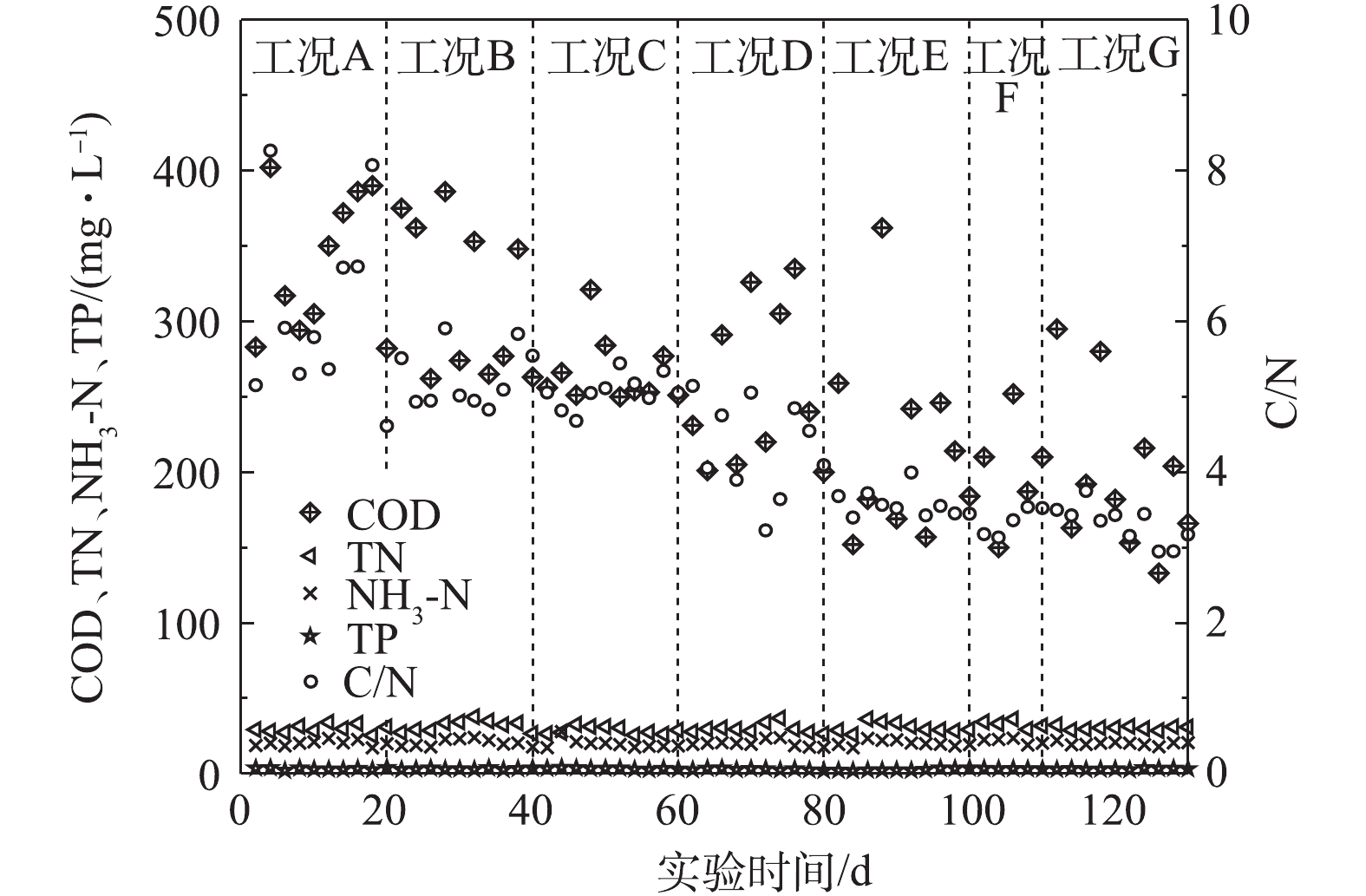
 下载:
下载:

